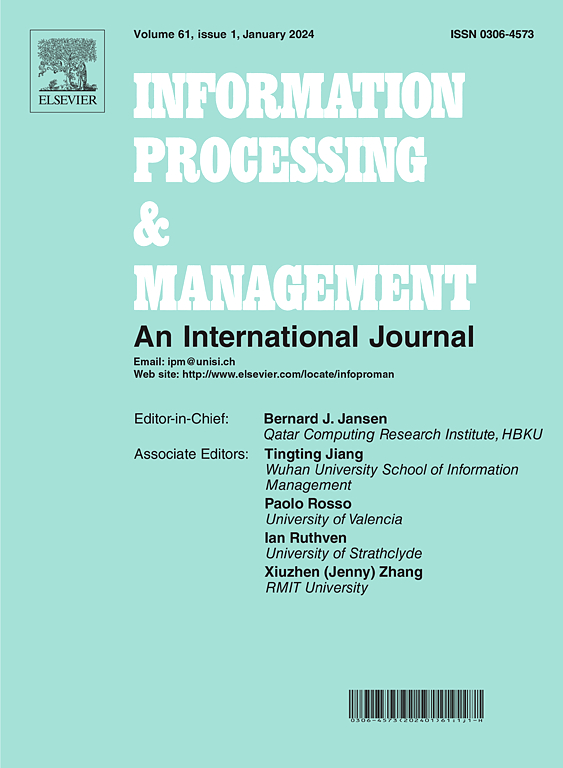Diff-GNDCRec: A diffusion model with graph-node enhancement and difference comparison for recommendation
IF 7.4
1区 管理学
Q1 COMPUTER SCIENCE, INFORMATION SYSTEMS
引用次数: 0
Abstract
Attention mechanism is widely used by Graph Neural Networks (GNNs) based recommender systems. However, data sparsity and noise can potentially disrupt the model, and consistence information within the graph structure may not fully capture the relative importance of graph nodes, which could influence the result of classification. Therefore, a diffusion model with graph-node enhancement and difference comparison for recommendation (Diff-GNDCRec) is proposed. Firstly, the feature vectors of the graph nodes are processed by Graph Convolutional Network (GCN) to obtain feature embedding, which is subsequently augmented by introducing Gaussian noise via a diffusion model. Secondly, augmented views of the graph nodes are generated through a multi-head Graph Attention Network (GAT) and denoised using average pooling to recover user interactions effectively. Finally, to better reflect the importance of the nodes, the model assigns weights to the nodes based on the neighborhood characteristics and combines the consistence and difference metrics to form the forward-supervised signals and contrast-supervised signals, respectively, and integrates them to improve the contrast learning effect. The model autonomously learns complex relationships between nodes, improving both recommendation accuracy and the model’s generalization capability in a fuzzy environment. Comparative evaluations with eleven benchmark models across three real-world datasets—Tmall, Amazon, and Gowalla—demonstrate that Diff-GNDCRec improves recall and normalized discounted cumulative gain by 1.26% to 3.32% and 1.37% to 4.12%, respectively. These results demonstrate the effect of Diff-GNDCRec.
基于图神经网络(GNN)的推荐系统广泛使用注意力机制。然而,数据稀疏性和噪声可能会破坏模型,图结构中的一致性信息可能无法完全捕捉图节点的相对重要性,从而影响分类结果。因此,我们提出了一种具有图节点增强和差异比较功能的扩散推荐模型(Diff-GNDCRec)。首先,通过图卷积网络(GCN)处理图节点的特征向量以获得特征嵌入,然后通过扩散模型引入高斯噪声对其进行增强。其次,通过多头图注意网络(GAT)生成图节点的增强视图,并使用平均池化技术去噪,从而有效恢复用户交互。最后,为了更好地反映节点的重要性,该模型根据邻域特征为节点分配权重,并结合一致性和差异性指标,分别形成前向监督信号和对比监督信号,并对它们进行整合,以提高对比学习效果。该模型能自主学习节点之间的复杂关系,从而提高了模糊环境下的推荐准确性和模型的泛化能力。Diff-GNDCRec 与 11 个基准模型在三个真实数据集(天猫、亚马逊和 Gowalla)上进行的比较评估表明,Diff-GNDCRec 将召回率和归一化折现累积增益分别提高了 1.26% 至 3.32%,以及 1.37% 至 4.12%。这些结果证明了 Diff-GNDCRec 的效果。
本文章由计算机程序翻译,如有差异,请以英文原文为准。
求助全文
约1分钟内获得全文
求助全文
来源期刊

Information Processing & Management
工程技术-计算机:信息系统
CiteScore
17.00
自引率
11.60%
发文量
276
审稿时长
39 days
期刊介绍:
Information Processing and Management is dedicated to publishing cutting-edge original research at the convergence of computing and information science. Our scope encompasses theory, methods, and applications across various domains, including advertising, business, health, information science, information technology marketing, and social computing.
We aim to cater to the interests of both primary researchers and practitioners by offering an effective platform for the timely dissemination of advanced and topical issues in this interdisciplinary field. The journal places particular emphasis on original research articles, research survey articles, research method articles, and articles addressing critical applications of research. Join us in advancing knowledge and innovation at the intersection of computing and information science.
 求助内容:
求助内容: 应助结果提醒方式:
应助结果提醒方式:


